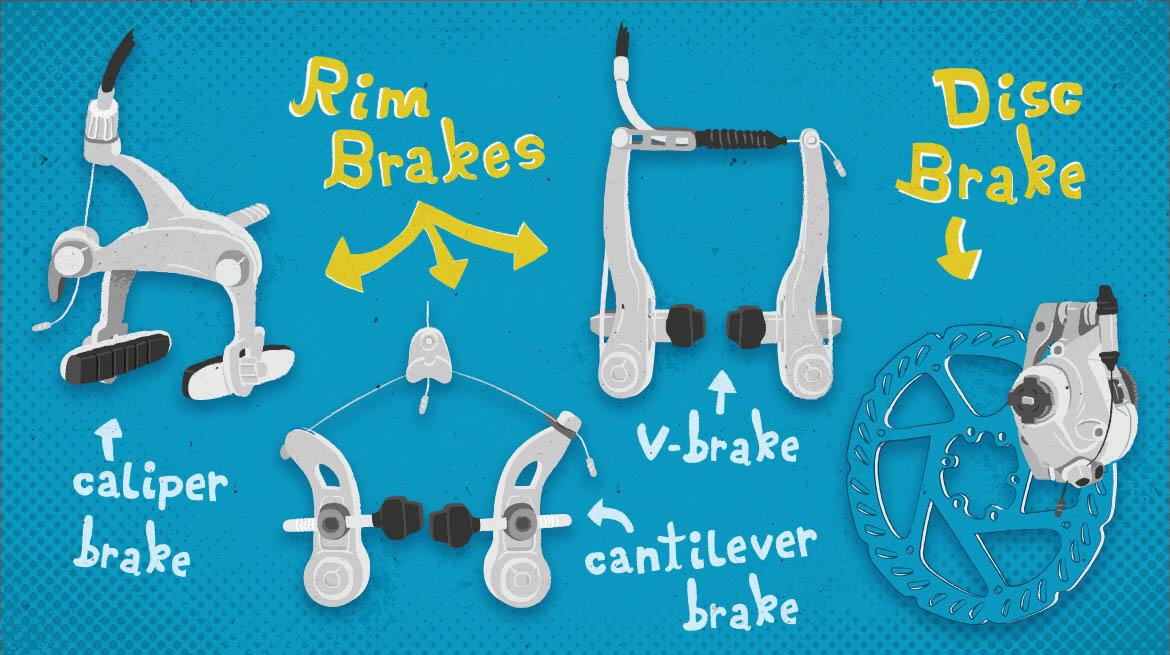Give Me a Brake
When you’re zooming down a mountain pass on a loaded touring bike, you will be counting on reliable, well-adjusted brakes. Most high-quality models will do the job, but there are some things you should consider before picking a brake set for your touring bike.
Disc Brakes
Disc brakes are the most significant advance in bicycle technology since suspension. Without question, they are the most precise and powerful style of brake. A few of the manufacturers already have them honed in well for bicycle use. The leader is Hayes Brake of Wisconsin, the same company that makes brakes for Harley Davidson and Ford.
In a disc brake system, a steel rotor is bolted to a special hub and a hydraulic- or cable-actuated caliper is bolted to the lower end of the fork or rear portion of the frame. When you pull your brake lever, extremely powerful pistons squeeze the rotor to provide stopping power.
Here are four advantages to disc brakes:
- Since there is no need for a flat braking surface on the rim, manufacturers are able to experiment with new weight-saving and strengthening techniques to improve rim designs.
- Rim brakes actually wear out rims over time by grinding away at the braking surface of the rim. This will cause some rims to crack.
- If the wheel goes out of true a bit, the performance of the brake will not be hindered and the wheel will turn freely, instead of rubbing on the brakes.
- On most models, the performance of the brake does not change with pad wear.

Wet, dry, muddy, dusty, hot, or cold, a good set of hydraulic disc brakes will outperform any other type of brake. Once properly installed, you might get a year or more of heavy use with no maintenance at all. However, installation and maintenance can be quite complicated and definitely requires expertise, unless you are a hard-core tinkerer.
V-brakes
Linear-pull or v-brakes are an evolved version of cantilever brakes that provide more power through increased leverage. Two things make this happen. The brake lever is designed to pull more cable, and the brake arms are longer and at a different angle.
V-brakes are a popular style of brake. They are still cable-actuated but far easier to adjust than traditional cantilever brakes. Pads are also much easier to replace than those on cantilever brakes.
Since v-brakes require that the lever has increased cable pull, if you want to use them in conjunction with a road bike-style brake lever, you will need to install an additional, but inexpensive, adapter to facilitate proper function.
There is a new original-equipment-model road lever that can work with both linear-pull and cantilever brakes, so it may not be long before linear-pull road levers are available for after-market sales.
Cantilever Brakes
Cantilevers were once cutting-edge and have proven to be adequate for loaded touring for many years, but now most manufacturers are now focusing their developmental efforts on linear-pull and disc-brake technologies.
Installing and adjusting the pads is much more difficult on cantilever brakes than it is on linear-pull brakes. Cantilevers are, however, the least expensive brakes and have been the touring standby for years. And, of the three styles discussed here, cantilevers are the most compatible with standard road levers; no adapter is needed.
Picking the Right Brake for You
Right about now you are probably thinking, that’s great information, Larry, but how do I decide what I should use?
I’d have to say that the all-around winner is a good set of linear-pull brakes. They provide excellent stopping power, are reasonably priced, and are the lowest maintenance of these three options. Linear-pull brakes are not likely to leave you completely brakeless, and, if you do have trouble while touring, any bike shop will be able to help you adjust or fix a linear-pull brake.
Linear-pull brake components like levers, cables, and pads are usually interchangeable between brands. This increases parts availability, and, if your brakes are not repairable, the bike shop will likely have an appropriate, affordable replacement set on the shelf that can be installed in a jiffy.
If, however, you are using a set of road brake levers that are not designed for linear-pull brakes, you may want to stick with cantilevers to avoid the hassle of using the required adapter.
There is no question that hydraulic disc brakes are the most powerful, most precise, and, therefore, the highest performance. I have a set on my mountain bike and wouldn’t have it any other way. However, potential maintenance issues make them a bit of a liability for touring purposes in certain parts of the world.
Variations between brands can create a problem. Disc brake systems require levers, calipers, rotors, and sometimes even cables that are all part of a unique system and not interchangeable between brands. If your brake lever fails, for example, you will need to replace it with one that was made for your system. This can create significant part-availability issues. There may come a day when disc brakes are the standard, but we are not there quite yet.
If you want disc brakes for your touring bike, consider a model that is cable-actuated rather than hydraulic. By using a cable-actuated rather than a hydraulic system, your brakes will be less prone to failure and more easily serviceable by the average mechanic. Cable-actuated models will provide at least as much stopping power as linear-pull brakes and will still provide the previously described advantages associated with non-rim brakes.
A Note on Tandems
Blair Winter, the bicycle product manager for Burley Design in Eugene, Oregon, feels that the most tried-and-true set up for loaded touring on a tandem is linear-pull brakes used in conjunction with a rear drum brake.
The drum brake is activated by a thumb shifter on the handlebar and provides adjustable drag to control the extra weight on long descents. The most popular drum brake is made by Arai and requires a special rear hub with threading on the left side of the hubshell.
Two of Burley’s top-of-the-line tandem models come disc brake-ready in anticipation of the day when there are disc brake models designed specifically for tandems.
